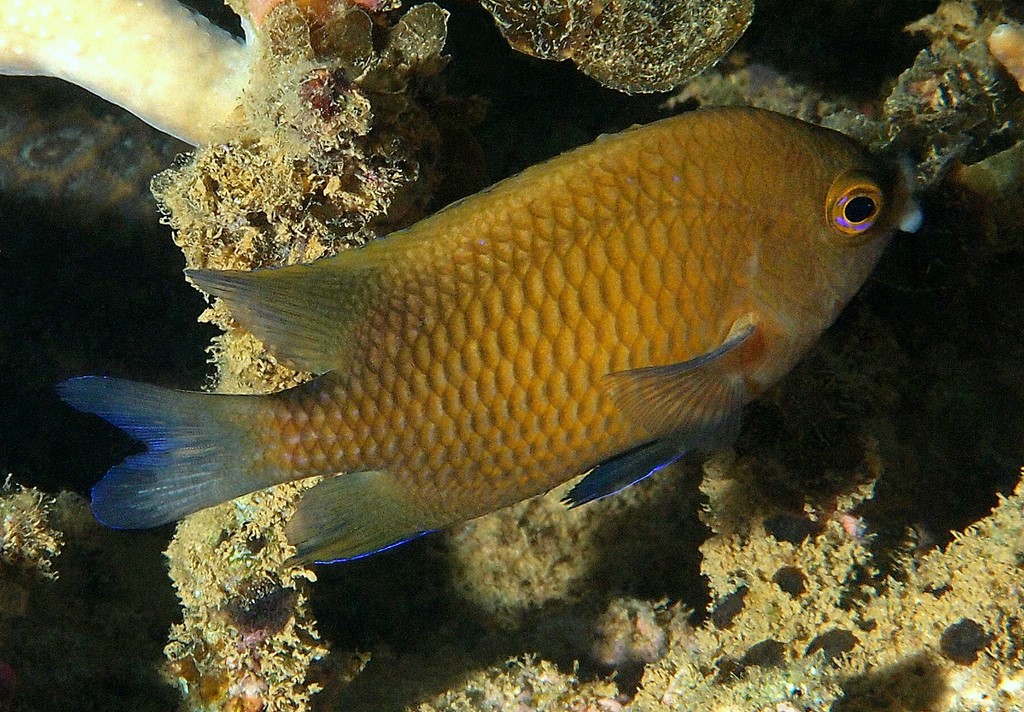CHEILOPRION LABIATUS - (DAY, 1877)
Actinopterygii (Gigaclass) > Actinopteri (Class) > Teleostei (Subclass) > Blenniiformes (Order) > Pomacentridae (Family) > Pomacentrinae (Subfamily) > Cheiloprion (Genus)
Demoiselle à grosses lèvres, Big-lip damsel, Big-lip damsel-fish, Biglip damsel, Biglip damselfish, Kissing damsel, Largelipped puller, Minstrel Fish, Storlæbet jomfrufisk, Atsukutchi-suzumedai, アツクチスズメダイ, 鋸唇魚, 厚唇雀鲷,
Synonyme
Pomacentrus labiatus (Day, 1877)
-------------------------
Description
Dorsal spines (total): 13; Dorsal soft rays (total): 13-14; Anal spines: 2; Anal soft rays: 13-14; Scales in lateral series: 26, with tubules: 18, between lateral line and origin of dorsal: 4, between lateral line and vent: 10. Body ovate, the outlines equally arched; Depth: 1.8-2.0 in length; Head: 2.6-2.8; Depth of caudal peduncle: 6.2-6.7. The wide, convex interorbital space: 2.6-3.0 in length of head, wider than length of maxillary, which is greater than that of snout; The blunt snout: 3.1-3.4 in head or about as long as diameter of eye; Preorbital at angle of mouth less than half an eye diameter; Maxillary extending posteriorly to a little before front edge of orbit. The extremely large and thick lips covered with outward radiating papillae drawn together into distinct furrows, and completely turned back around mouth, thus exposing the teeth. Teeth in two rows of equal length in each jaw, minute, strongly compressed laterally, of uniform height, with slightly rounded tips. Suborbital bone and posterior margin of preopercle with fine denticulations. Scales on top of head extending to nostrils, those at base of dorsal fin high; Orbital ring naked. Middle and posterior dorsal spines about equal in height; Soft dorsal pointed; Rayed anal a little rounded; Ventrals extending to origin of anal; Caudal slightly forked, with the lower lobe a little shorter than upper. Max. length: 6.0 cm SL. Depth range: 1 - 10 m.
Color
Brown body, often a darker area towards the rear of the body, a small dark spot at the top of the gill opening, and a narrow bluish margin on the fins.
Etymology
Cheiloprion: from Greek, cheilos = lip + from Greek, prion = saw. Referring to its thick lips and referring to its finely serrated preopercle.
labiatus: from Latin, labium = lip, lipped. Reffering to the the enormously developed lips which are puffed out and covered with radiating papillae.
Original description: Pomacentrus labiatus Day, 1877 - Type locality: Andaman and Nicobar Islands, Bay of Bengal, eastern Indian Ocean.
Distribution
Eastern Indian Ocean, western Pacific: Andaman Islands and Bangladesh east to Philippines and Vanuatu, south to northern Australia and New Caledonia.
Biology
Found usually among beds of branching corals in shallow lagoon reefs, singly or in small groups. Feed primarily on the polyps of Acropora corals and presumably the big lips of this fish provides some protection against the sharp coral skeleton. Oviparous, distinct pairing during breeding. Eggs are demersal and adhere to the substrate. Males guard and aerate the eggs.
Last update: 9, March 2023
Demoiselle à grosses lèvres, Big-lip damsel, Big-lip damsel-fish, Biglip damsel, Biglip damselfish, Kissing damsel, Largelipped puller, Minstrel Fish, Storlæbet jomfrufisk, Atsukutchi-suzumedai, アツクチスズメダイ, 鋸唇魚, 厚唇雀鲷,
Synonyme
Pomacentrus labiatus (Day, 1877)
-------------------------
Description
Dorsal spines (total): 13; Dorsal soft rays (total): 13-14; Anal spines: 2; Anal soft rays: 13-14; Scales in lateral series: 26, with tubules: 18, between lateral line and origin of dorsal: 4, between lateral line and vent: 10. Body ovate, the outlines equally arched; Depth: 1.8-2.0 in length; Head: 2.6-2.8; Depth of caudal peduncle: 6.2-6.7. The wide, convex interorbital space: 2.6-3.0 in length of head, wider than length of maxillary, which is greater than that of snout; The blunt snout: 3.1-3.4 in head or about as long as diameter of eye; Preorbital at angle of mouth less than half an eye diameter; Maxillary extending posteriorly to a little before front edge of orbit. The extremely large and thick lips covered with outward radiating papillae drawn together into distinct furrows, and completely turned back around mouth, thus exposing the teeth. Teeth in two rows of equal length in each jaw, minute, strongly compressed laterally, of uniform height, with slightly rounded tips. Suborbital bone and posterior margin of preopercle with fine denticulations. Scales on top of head extending to nostrils, those at base of dorsal fin high; Orbital ring naked. Middle and posterior dorsal spines about equal in height; Soft dorsal pointed; Rayed anal a little rounded; Ventrals extending to origin of anal; Caudal slightly forked, with the lower lobe a little shorter than upper. Max. length: 6.0 cm SL. Depth range: 1 - 10 m.
Color
Brown body, often a darker area towards the rear of the body, a small dark spot at the top of the gill opening, and a narrow bluish margin on the fins.
Etymology
Cheiloprion: from Greek, cheilos = lip + from Greek, prion = saw. Referring to its thick lips and referring to its finely serrated preopercle.
labiatus: from Latin, labium = lip, lipped. Reffering to the the enormously developed lips which are puffed out and covered with radiating papillae.
Original description: Pomacentrus labiatus Day, 1877 - Type locality: Andaman and Nicobar Islands, Bay of Bengal, eastern Indian Ocean.
Distribution
Eastern Indian Ocean, western Pacific: Andaman Islands and Bangladesh east to Philippines and Vanuatu, south to northern Australia and New Caledonia.
Biology
Found usually among beds of branching corals in shallow lagoon reefs, singly or in small groups. Feed primarily on the polyps of Acropora corals and presumably the big lips of this fish provides some protection against the sharp coral skeleton. Oviparous, distinct pairing during breeding. Eggs are demersal and adhere to the substrate. Males guard and aerate the eggs.
Last update: 9, March 2023
